[found on Google books, from the
Harmsworth Magazine, 1898/99]
 |
| THE PRIME MINISTER'S (10, Downing Street, Westminster.) |
What souvenir of a great man can compete with the knocker of his door? A
door-knocker is to a man's house what a sign is to a shop or tavern; but
it is also something more. Take, for instance, the knocker on the door
of the official residence of the Prime Minister, No. 10, Downing Street.
No less a person than Lord Beaconsfield once described to a friend this
particular knocker as having a marked resemblance to the features of his
political opponent, Mr. Gladstone. There is no knocker in existence, we
may fairly state, that has been handled by so many distinguished people
as this one. If only the friends of Mr. Gladstone were enumerated, they
would make up a long list of illustrious names, and many Prime Ministers
have resided at the unpretentious, old-fashioned mansion so conveniently
situated for the Houses of Parliament.
The knocker on the door of Carlyle's house, Cheyne Row, Chelsea, a house
which was occupied by him for half a century, is another very
interesting specimen. Scarcely was the young ex-schoolmaster and author
of "Sartor Resartus" well settled in his new abode than he began to
receive callers, who, if not very famous then, have since achieved
considerable renown.
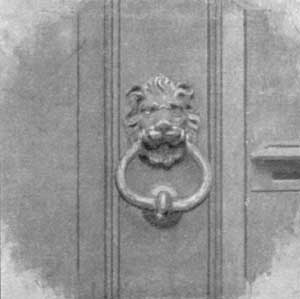 |
| THOMAS CARLYLE'S. (Cheyne Row, Chelsea.) |
Among them was young Mr. Charles Dickens, then the blushing "Boz," who,
with Mrs. Dickens, stepped out of a gorgeous green hackney coach to
administer a knock on the door, having driven all the way from Doughty
Street, Brunswick Square, to pay a call. Forster, Serjeant Talfourd,
Maclise, Macready, Landor, Leigh Hunt, and Thackeray were frequent
knockers during the first decade.
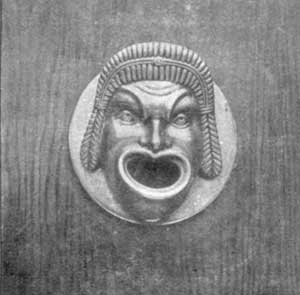 |
| MR. ALMA TADEMA'S. (St. John's Wood.) |
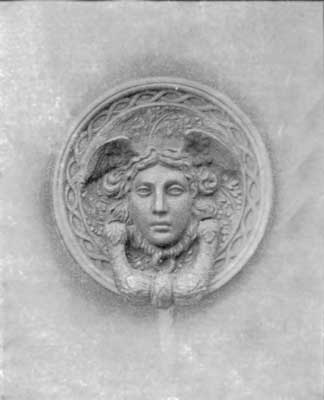 |
| THE DUKE OF DEVONSHIRE'S.
(Piccadilly.) |
It is not difficult to imagine some youthful admirer of Carlyle giving a
timid knock at the door, and then wishing that he had the courage to run
away from the house before being ushered into the presence of the
irascible Philosopher. Mr. Alma Tadema's knocker is forbidding enough
in
appearance, and holds out but little promise of the beauties of that
wonderful house where the artist resides in St. John's Wood. No doubt it
is, like everything else about his home, from a design by the great
painter himself.
The most beautiful knocker in this collection, if not the most beautiful
in London, is that of the Duke of Devonshire, at No. 80, Piccadilly. It
represents a head of classic contour set in a circular disc, chiselled
with an exquisite border. Not a few among the Duke's guests have so far
expressed their admiration of this work of art as to desire duplicates
for themselves, but it is not known if any exist, it having been done by
the Duke's own command from his own designs.
It is to be wished that the Duke would follow up his artistic success in
this particular by designing a wall for Devonshire House to replace the
existing hideous structure.
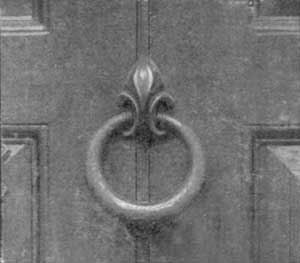 |
CHARLES DICKENS'.
(17, Doughty Street.) |
Dickens' door-knocker recalls the residence of the happy couple who
removed to Doughty Street from Furnival's Inn shortly after their
marriage. It was here that Charles Dickens the younger was born, and
where the author of "Pickwick" first became on terms of friendship with
many of the brilliant men of letters of his day. The knocker is held in
its place by a fleur-de-lis of the same metal, and it was Serjeant
Talfourd who humorously rallied Dickens on his supposed predilection for
the French, who at that time were in the midst of preparing that series
of more or less revolutionary movements which preceded the downfall of
Louis Philippe and the ascendency of the third Napoleon.
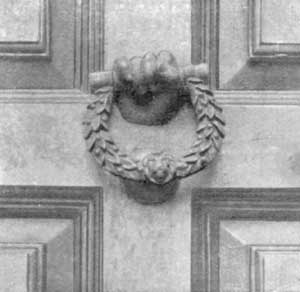 |
DR. JOHNSON'S.
(Bolt Court, Fleet Street.) |
But an older and more characteristic door-knocker may be found well
within a mile of Doughty Street, still on the door of a house once
inhabited by the great sage Dr. Samuel Johnson himself. Surely if any
knocker is characteristic of its owner this one is. It represents a
sturdy fist clenching a baton from which depends a bulky wreath of
laurel fastened in the middle by a lion's head. The worthy doctor, as we
are told by Boswell, carried no key, nor did he permit any member of his
oddly-selected household to possess one. At all times and seasons the
house in Bolt Court was
inhabited, and unquestionably the burly knocker
resounded in the ears of the inhabitants of the court often enough, and
at unseemly hours, for the sage was not at all scrupulous as to what
hours he kept, and many a time would talk irregularly on at the club
until some of his neighbours had serious thoughts of rising.
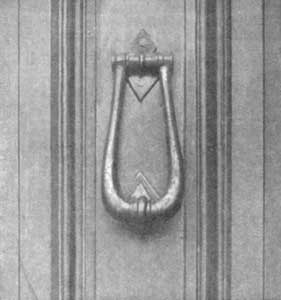 |
CRUIKSHANK'S.
(Hampstead Road, N.W.) |
The contemporaries of the great caricaturist George Cruikshank during a
fruitful period of his life will gaze not without feelings of emotion on
the accompanying representation of the familiar knocker on his house in
the Hampstead Road.
It was Clarkson Stanfield who, calling upon his friend Cruikshank one
day, had much ado in making the artist's aged servant aware that a
visitor awaited at the portals; again and again he knocked, but in vain;
the servant's deafness was proof against the onslaughts of a vigorous if
not wholly artistic door implement. At last, losing all patience, he
picked up the foot-scraper and was about to impetuously hammer away at
the panels, when the caricaturist, hastily throwing up an upper window
sash, recognised and appeased his indignant visitor.
"You should," remarked Stanfield, "get a younger servant, or a heavier
knocker, or else build your house in Turkish fashion—that is, without
doors."
In every article which deals with the curiosities of London, the name of
Dickens must figure very largely. The last knocker of our collection is
the most remarkable one of all, inasmuch as Dickens derived his idea of
Scrooge in "A Christmas Carol" from its hideous lineaments. Look at our
photograph and then read Dickens' own description of the unamiable
Scrooge:
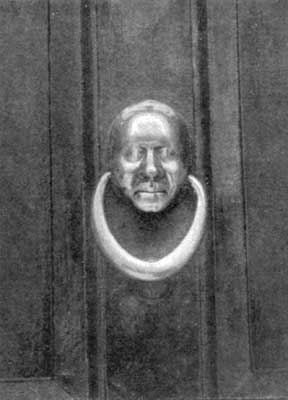 |
THE KNOCKER THAT SUGGESTED SCROOGE
IN DICKENS' "CHRISTMAS
CAROL."
(8, Craven Street, Strand.) |
"Oh! but he was a tight-fisted hand at the grindstone, Scrooge; a
squeezing, wrenching, grasping, scraping, clutching, covetous, old
Sinner! Hard and sharp as flint, from which no steel had ever struck out
generous fire; secret, and self-contained, and solitary as an oyster.
The cold within him froze his old features, nipped his pointed nose,
shrivelled his cheek, stiffened his gait.... He carried his own low
temperature always about with him; he iced his office in the dog-days;
and didn't thaw it one degree at Christmas."









Very entertaining! It would be fun to put these on HistoryPin
ReplyDeleteGorgeous! I can't wait to have my own doorknocker one day. It will probably be a lion's head, but I am open to suggestions.
ReplyDeleteYou should call 7508586840 on our number and get any kind of help regarding shutters installation,Shop Doors , maintenance work etc.
ReplyDeleteDid he ever sketch the NO 10Downing Street Knocker
ReplyDelete